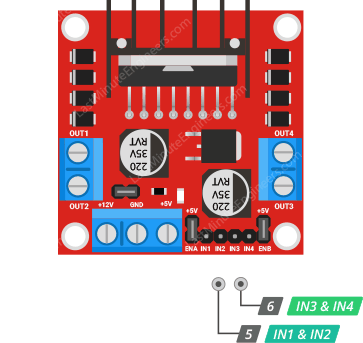Motor driver
L298N Motor Driver
What is the L298N Motor Driver?
The L298N is a widely used dual H-Bridge motor driver module designed to facilitate the control of the direction and speed of DC motors. An H-Bridge is a specific arrangement of transistors that allows current to flow in either direction through the motor, enabling it to rotate clockwise or counterclockwise. The L298N is particularly popular in robotics and automation projects due to its ability to control two motors independently, making it an essential component for any mobile robot that requires precise movement.

Key Features of the L298N Motor Driver:
-
Dual H-Bridge Configuration:
- The L298N can control two DC motors simultaneously, allowing for complex movement patterns such as turning and rotating. Each motor can be controlled independently, enabling applications like differential steering, where each wheel can rotate at different speeds to navigate tight corners or perform maneuvers.
-
High Current Rating:
- This motor driver can handle a continuous current of up to 2A per channel. This capacity is crucial for powering motors like the BO motors used in the Jarvis Bot, which require sufficient current to operate effectively, especially under load or during acceleration.
-
Built-in Diodes:
- The L298N includes built-in flyback diodes that protect the circuit from back Electromotive Force (back EMF). Back EMF is generated when the motor is suddenly stopped or when its direction is changed, which can cause voltage spikes that might damage the driver or the connected microcontroller. The diodes safely redirect this back EMF, ensuring the longevity and reliability of the motor driver.
-
Voltage Range:
- The L298N operates within a wide voltage range of 5V to 46V, making it versatile for various motor types and applications. This flexibility allows users to adapt the driver for different motors as their project requirements change, making it a good choice for educational and prototype projects.
-
Simple Control Interface:
- The L298N can be easily interfaced with microcontrollers like Arduino and Raspberry Pi. It uses digital signals to control the direction and speed of the motors. By applying Pulse Width Modulation (PWM) to the control pins, users can effectively regulate the motor speed, which is crucial for applications that require precise movement.
Applications in Robotics:
In the context of the Jarvis Bot, the L298N motor driver plays a critical role in enabling the robot's mobility. Here are some specific applications and advantages it offers:
-
Smooth Movements: The ability to control the speed and direction of the BO motors allows the Jarvis Bot to navigate smoothly through its environment. It can start, stop, and change direction with precision, which is particularly important in educational settings where demonstrations and experiments are conducted.
-
Accurate Positioning: With the L298N, the Jarvis Bot can perform accurate movements required for tasks like following a line, avoiding obstacles, or executing programmed paths. This level of control enhances the robot's functionality and expands its range of potential applications.
-
Differential Drive Mechanism: The L298N enables the implementation of a differential drive mechanism, where each wheel (powered by a BO motor) can be controlled independently. This configuration allows the Jarvis Bot to pivot, turn in place, and maneuver through tight spaces, which is essential for navigating various terrains or performing complex tasks.
-
Integration with Other Sensors: The L298N can be combined with various sensors (like distance or light sensors) to create more advanced functionalities. For example, the Jarvis Bot can use feedback from these sensors to adjust its speed and direction in real-time, allowing for autonomous navigation and interaction with its environment.
Conclusion
The L298N motor driver is an indispensable component for the Jarvis Bot, providing the necessary control over the BO motors to enable complex movements and tasks. Its robust features, including dual motor control, high current rating, built-in protection, and voltage versatility, make it ideal for both educational and experimental robotics projects. By understanding the capabilities of the L298N, users can leverage its full potential to enhance the functionality and performance of their robotic systems.